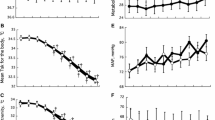Summary
The deep-inspiration-induced vasoconstrictor reaction in the vascular bed of acral regions of the skin consists of a series of reflex adjustments of the vascular lumen. The duration of this reaction and its size, as expressed by the area of the vasoconstrictor downward deflection of the plethysmographic curve, are functions of the time intervals between the deep inspirations, up to an interval value of 3 to 4 minutes. The size of the same parameters undergoes periodic fluctuations if the intervals between the stimuli are kept constant. They can be further enhanced by startle reactions to a new sound in the surroundings, or by a collision during the elaboration of a conditioned reflex that does not surpass the level of the consciousness (conditioned saccadic eye movements). The vasoconstrictor reflex under consideration can be readily conditioned. Two types of its conditioning are described. Further it can be shown that it is depressed by little doses of reserpine (0.50 mg. perorally) even in normotensive healthy subjects.
Zusammenfassung
Die durch tiefes Einatmen hervorgerufene vasokonstriktorische Reaktion des Gefäßsystems der akralen Hautgebiete besteht aus einer Reihe von reflektorischen Einstellungen des Gefäßlumens. Die Dauer dieser Reaktion und ihre Größe werden durch die Fläche ausgedrückt, die von dem nach unten gerichteten Ausschlag der plethysmographischen Kurve abgegrenzt wird und hängen von den Zeitspannen zwischen den einzelnen Einatmungen ab, bis zum Intervallwert von 3 bis 4 Minuten. Die Größe derselben Parameter erfährt periodische Schwankungen, wenn die Intervalle zwischen den Reizen konstant gehalten werden. Durch Schreckreaktionen auf ein neues Geräusch in der Umgebung oder durch einen Zusammenstoß während der Ausarbeitung eines bedingten Reflexes, der die Ebene des Bewußten nicht überschreitet (bedingte sakkadische Augenbewegungen) werden sie größer. Der erwähnte vasokonstriktorische Reflex kann leicht bedingt werden. Zwei Typen seiner Bedingung sind beschrieben. Er kann von einer kleinen Dosis-Reserpin (0.50 mg per os) unterdrückt werden, und zwar auch bei gesunden, normotensiven Menschen.
Résumé
La réaction vasoconstrictrice produite par une profonde inspiration, observée dans les zones acrales cutanées, consiste d'une série d'adaptions réflexes de la lumière vasculaire. La durée, et la grandeur de cette réaction, définie par la superficie délimitée de déflexion négative de la courbe pléthysmographique, sont des fonctions des intervalles entre les inspirations profondes, jusqu'à leur valeur de 3 à 4 min. La mesure des mêmes paramètres est sujette à des oscillations périodiques si les intervalles entre les stimulus restent constants. Ils sont augmentés par des réactions d'effroi à des bruits d'ambiance ou par une collision au cours de l'élaboration du réflexe conditionné qui ne surpasse pas le niveau de conscience (les mouvements des yeux saccadés). Le réflexe vasoconstricteur en question est facile à conditionner. Deux types de son élaboration sont décrits. Il peut être déprimé par des petites doses de réserpine (0.50mg per os) même chez des sujets sains, à tension sanguine normale.
Similar content being viewed by others
References
Moso, A., Über den Kreislauf des Blutes im menschlichen Gehirn. Leipzig, 1881.
Bolton, B., E. A. Carmichael andG. Stürup, Vasoconstriction following deep inspiration. J. Physiol., London,86 (1936), 83.
Uhlenbruck, P., Plethysmographische Untersuchungen am Menschen. II. Teil. Die Spontanschwankungen des Extremitätenvolumens und der Einfluß der Atmung auf dasselbe. Zschr. Biol.80 (1924), 317.
Goetz, R.H., Der Fingerplethysmograph als Mittel zur Untersuchung der Regulationsmechanismen in peripheren Gefäßgebieten. Pflügers Arch. Physiol.235 (1935), 271.
Hertzmann, A. B., andJ. B. Dillon, Selective vascular reaction patterns in the nasal septum and skin of the extremities and head. Amer. J. Physiol.127 (1939), 671.
Hertzmann, A. B., andJ. B. Dillon, Reactions of large and small arteries in man to vasoconstrictory stimuli. Amer. J. Physiol.130 (1940), 56.
Gilliat, R. W., Vasoconstriction in the finger after deep inspiration. J. Physiol., London,107 (1948), 76.
Cerletti, A., Plethysmographische Untersuchungen (3. Mitteilung). Über vergleichende plethysmographische Untersuchungen an Hand und Fuß. Helvet. physiol. pharmacol. acta3 (1945), 537.
Matthes, K., Kreislaufuntersuchungen am Menschen mit fortlaufenden registrierenden Methoden. Thieme Verlag, 1951.
Duggan, J. J., V. L. Love andR. H. Lyons, A study of reflex venomotor reactions in man. Circulation7 (1953), 896.
Page, E. B. and coll., Reflex venomotor activity in normal persons and patients with postural hypotension. Circulation11 (1955), 262.
Burch, G. F., andM. Murtadha, A study of the venomotor tone in short intact venous segment of the forearm of man. Amer. Heart J.51 (1956), 907.
Martin, D. A., N. L. White andCh. R. Vernon, Influence of emotional and physical stimuli on pressure in the isolated vein segment. Circulation7 (1959), 580.
Thorn, H. L., K. D. Scheppokat andA. Hintze, Über das Verhalten der Kapazitiven und der Widerstandsgefäße der menschlichen Hand im Verlaufe einer durch tiefe willkürliche Inspiration ausgelösten kurzdauernden Vasoconstriction. Pflügers Arch. Physiol.270 (1960), 239.
Ruttkay-Nedecký, I., andE. Kellerová, Central nervous influence on the intensity of vasoconstriction in the acral skin region induced by a deep inspiration. Act. nerv. super.2 (1960), 407.
Ochnjanska, L. G., Issledovanije uslovnovo dychatelno-sosudistovovo refleksa. Fyziol. žurn. SSSR.34 (1953), 610.
Author information
Authors and Affiliations
Additional information
With 6 Figures
Rights and permissions
About this article
Cite this article
Ruttkay-Nedecký, I. Vasoconstrictor reflex in acral skin regions after taking a deep breath. Acta Neurovegetativa 24, 413–420 (1962). https://doi.org/10.1007/BF01233012
Issue Date:
DOI: https://doi.org/10.1007/BF01233012



